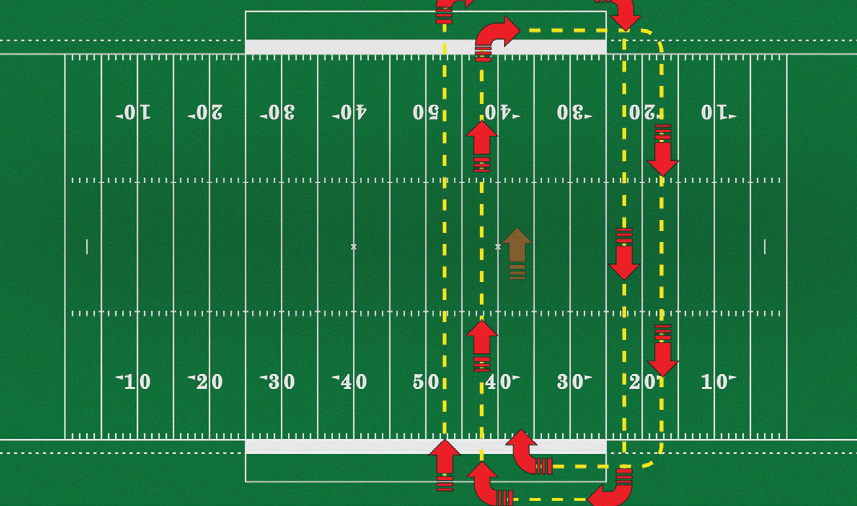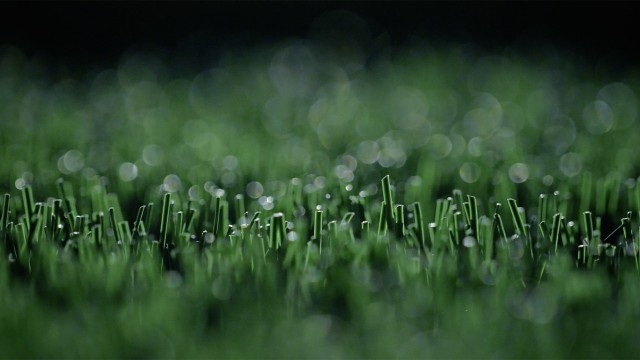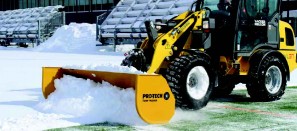Properly caring for your artificial turf field during the winter months will greatly simplify your spring maintenance and overall field health.
While it may seem daunting, winter maintenance is actually rather simple, if you follow our recommended guidelines. Incorrect maintenance however can lead to severe field issues so please reach out to your FieldTurf Service Expert for questions prior to performing maintenance. Our leading FieldCare Team can also help perform the required winter maintenance and spring opening – Learn more Here.
The components that make up your FieldTurf system don’t freeze, but the moisture that seeps into the infill does. This allows you to safely plow the field without moving (or removing) a significant amount of infill.
Let’s get started. Here are the proper steps to follow when plowing snow and caring for your FieldTurf surface:
FALL - STEP ONE: KEEP IT CLEAN IN THE FALL
Properly sweeping and removing debris from the field in the fall will lead to a simpler winter and spring maintenance. Any debris left on the field (leaves or branches for example) can break down over the course of the winter and contaminate your surface.
FALL - STEP TWO: BRUSHING & RAKING
Prior to winter, we recommend performing a brushing session to help lift matted fibers and a raking session to decompact the infill of your synthetic turf surface. Both are recommended after sweeping; in order to ease the drainage process and prevent compaction buildup come spring.
FieldTurf has a collection of exclusive sweepers and maintenance equipment specialized for our surface. Learn more Here.

FALL - STEP THREE: PREPARING YOUR EQUIPMENT & SNOW PLACEMENT
It’s key to plan and prepare a dedicated area for snow removal. Preferably, the area is off the surface of play. For plowing, FieldTurf recommends the use of the Turf Pusher by Pro-Tech. Any equipment / vehicle used to remove snow from the artificial turf field should not exert more than 70 PSI (pound-force per square inch) of pressure on the field and subbase. The use of turf tires are recommend.
WINTER – STEP FOUR: PLOW SNOW FROM THE FIELD
The ideal climactic conditions for plowing are always below freezing — FieldTurf recommends a safety threshold of below 25 degrees F and minus -5 degrees C for plowing. Planning snow removal early in the morning or late in the afternoon is preferred.
Keep pace with snowfall and regularly plow the field, so the snow and ice doesn’t accumulate and harden. We recommended to plow from sideline to sideline and leave a thin crust of 1” to 1.5” on the surface, which will act as a layer of security. The remaining layer will be melted by the sun.

SPRING – STEP FIVE: FIELD INSPECTION & PREPARATION FOR PLAY
Once the snow and ice is full removed, it’s time to inspect your field’s condition. Examine for potential tears, variation in surface heights and perform infill depth measurements in a variety of spots to ensure infill hasn’t been displaced during plowing. Prior to play perform a sweeping and brushing session.
Our FieldCare Team is here to help perform snow plowing and field preparation. Learn more Here.

MOST ASKED QUESTIONS
WHAT ABOUT TARP?
Installing a field tarp is permitted but has demonstrated to cause enhanced condensation and freezing leading to unfavorable results.
CAN I USE ICE MELTERS ON THE FIELD?
The rotating tines on the FieldTurf GroomRight can be used to break up the remaining layer of ice. Proceed with caution using this machine to disturb or remove infill.
If you opt to use a de-icing substance, always test it off the main field of play first to protect the safety of the surface; some de-icing solutions leave a sticky residue behind. The warm brine from calcium chloride solutions, while an effective melting agent, does leave a residue that can affect ball handling, ball reaction and footing.
Calcium chloride solutions, despite the residue potential, are preferred over sodium chloride ones. Magnesium chloride also is acceptable. Aside from any issues with potential corrosion of exposed metal, magnesium chloride won’t harm the turf. Regular salt dries into hard, abrasive crystals that can scuff the fibers. Magnesium chloride, because it picks up moisture from the air, will produce less abrasion.
FieldTurf recommends to flush the field with water to remove potential chemical residue once the outdoor temperature has been above freezing for five consecutive days and the upcoming weather forecast is favorable.


